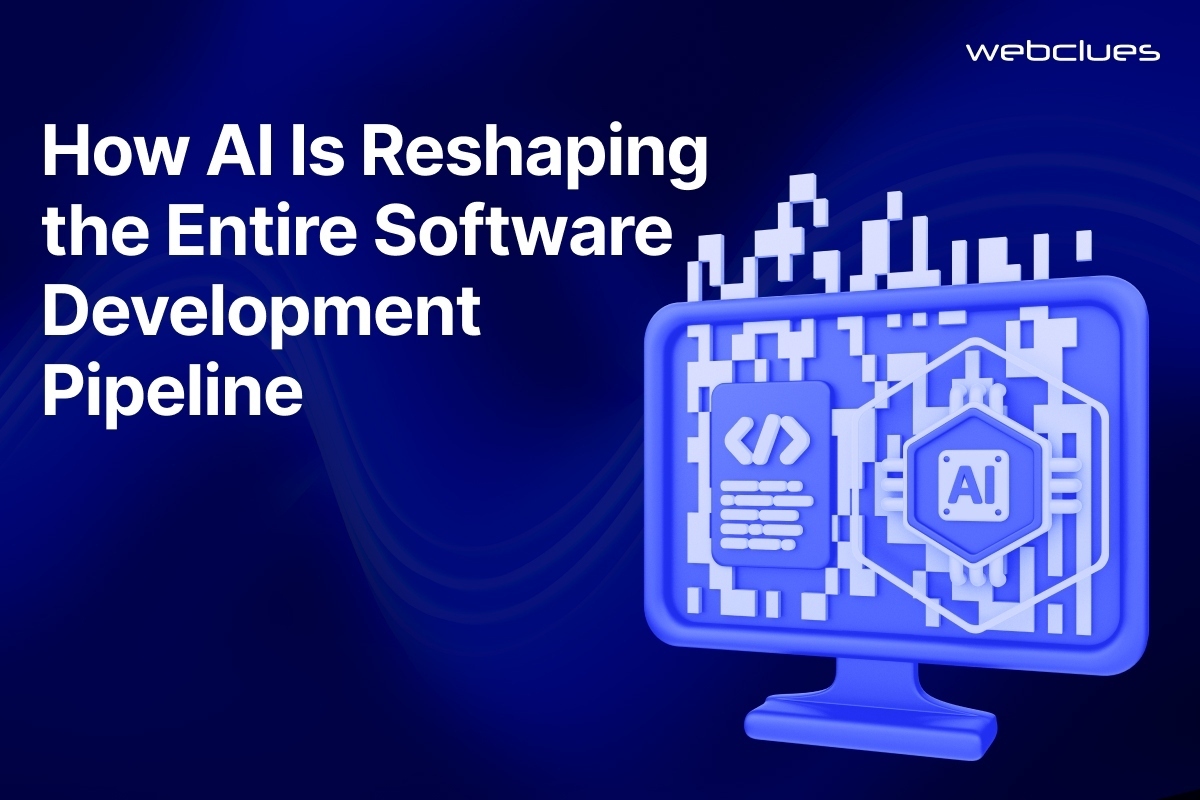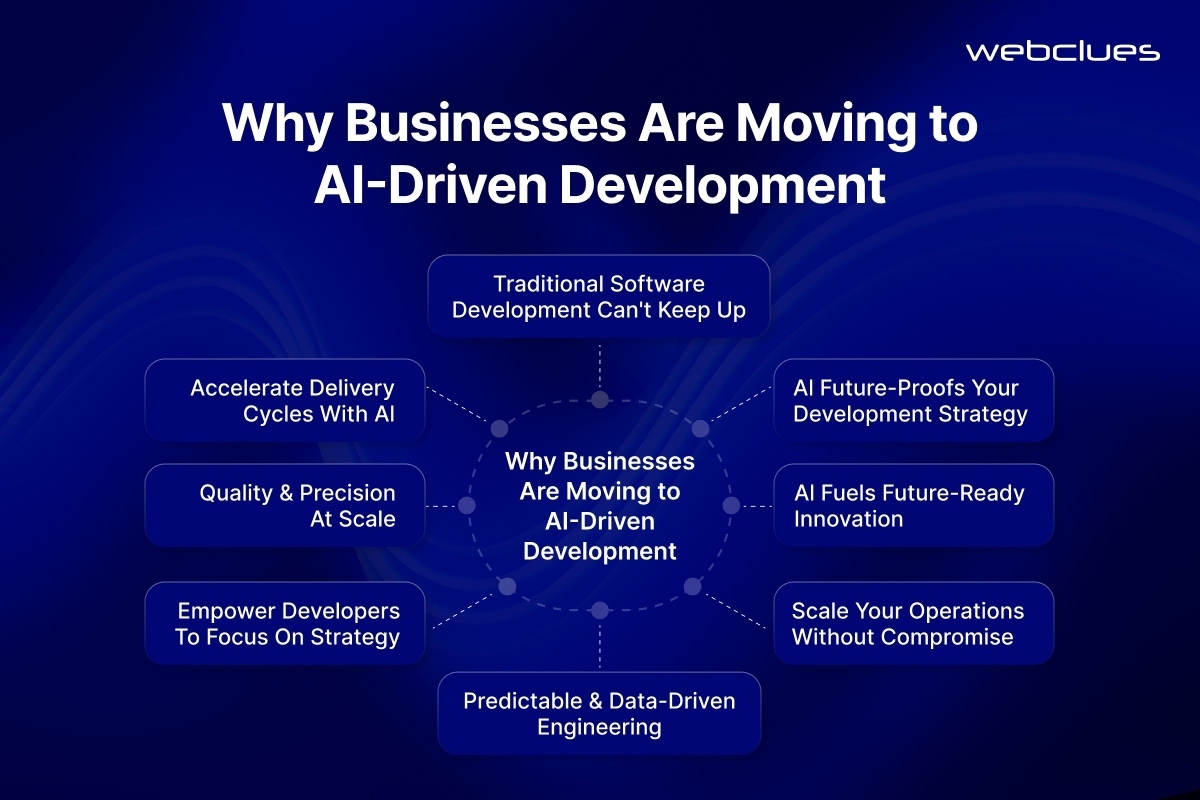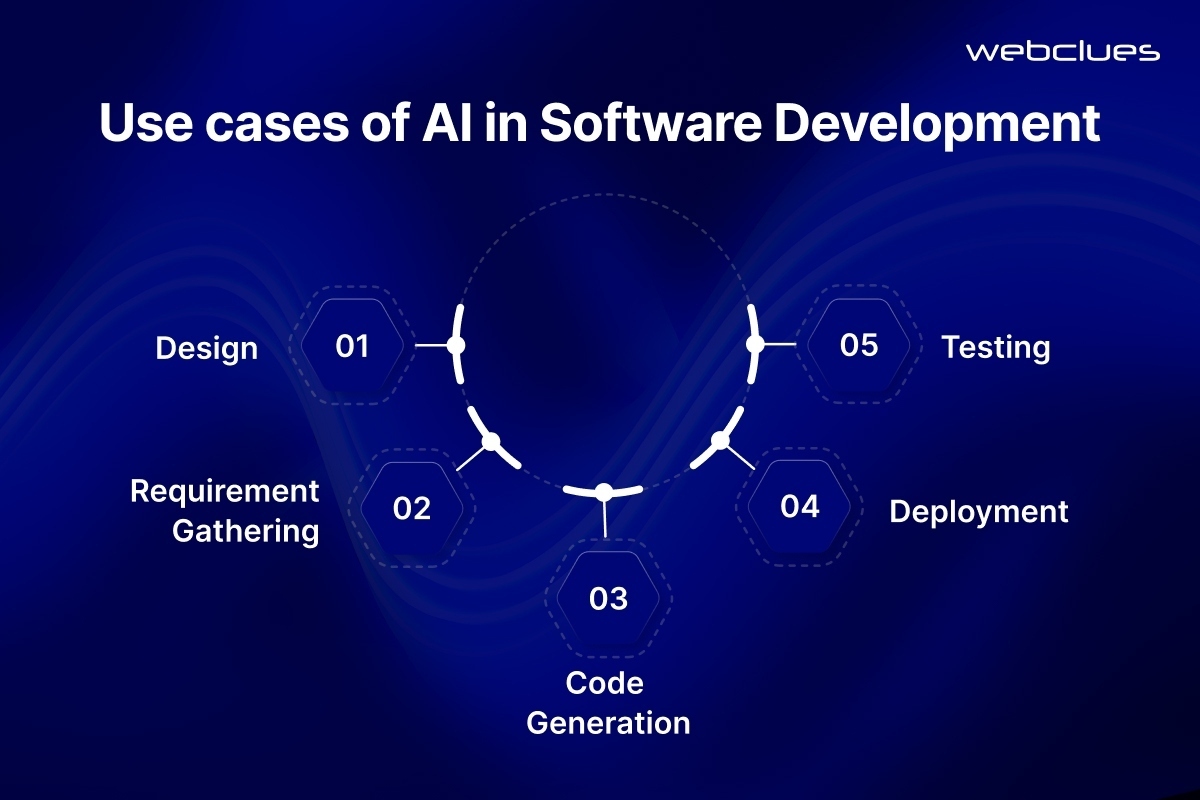How AI Is Reshaping the Entire Software Development Pipeline

GitHub Copilot brought AI into the mainstream for developers. It proved that machines could assist with writing code, saving time on repetitive tasks and helping engineers move faster. But Copilot was only the beginning.
What started as autocomplete for code has now expanded into something much bigger. AI is no longer confined to the IDE. It’s being used to plan sprints, estimate timelines, generate documentation, test software, and even monitor live systems. From architecture to deployment, every part of the development pipeline is seeing the impact.
This shift is giving rise to a new kind of workflow. AI-powered software development doesn't just speed things up; it changes how teams operate. It’s not about replacing people. It’s about building smarter systems that assist, guide, and sometimes even make independent decisions.
This is where AI-driven development stands today. And it’s just getting started.
Why Businesses Are Moving to AI-Driven Development

Software development is no longer just about writing clean code. It’s about how fast a team can build, test, and release reliable products. In today’s environment, speed and stability aren’t trade-offs. They’re both required. That’s why more businesses are turning to AI-driven development.
AI is helping teams reduce bottlenecks across the board. Project managers use it to generate timelines. Developers use it to generate code. QA teams use it to detect bugs before users ever see them. This shift is not just about automation. It’s about creating workflows that adjust in real time and reduce waste at every step.
Many organizations are now following AI-first development approaches. This means thinking about where AI can fit into planning and execution from day one. Not as an afterthought, but as a structural part of how products are built.
For businesses without internal expertise, working with an experienced AI development company offers a clear advantage. It allows them to adopt these tools without guesswork and apply them across the full development cycle. The result is faster delivery, lower risk, and better output.
AI Across the Software Development Pipeline
Let’s break down where and how AI is being used at every stage.

Planning & Ideation
At the earliest stages of a project, AI is becoming a practical tool for decision-making. In project management, it helps teams gather requirements, estimate timelines, and shape the initial scope with greater accuracy. Teams can feed historical project data into AI tools to get rough delivery timelines or predict task complexity.
During sprint planning, AI can suggest task splits based on previous work patterns. Product managers use smart assistants to sort through backlogs, prioritize items, and identify blockers before development even begins.
Architecture design is also getting early support from AI. By analyzing similar past systems or suggesting templates, AI can help teams sketch out technical direction faster. These are the first signs of what many now refer to as an AI-first development approach.
Coding & Build
The coding phase is where most people first encounter AI. Tools like Copilot, Cursor, and Tabnine assist with writing boilerplate code, suggesting functions, and generating entire blocks based on intent.
AI coding tools now do more than autocomplete. Developers rely on them to generate repetitive structures, comment code, and even create initial test cases alongside builds. Some tools integrate deeply with version control and workspaces, offering in-line help, code explanations, and refactoring suggestions.
There’s also growing interest in AI pair programming. Tools like Cody or Replit's Ghostwriter offer experiences that feel like working with a second developer, ready to catch mistakes or offer ideas.
This part of the pipeline is still developing fast, and while Copilot started the trend, it’s far from the only option now.
Testing & QA
Testing is often where projects slow down, but AI is changing that. Teams can now auto-generate test cases directly from code, cutting time spent on manual scripting. These tools learn from past bugs and test patterns to build more relevant coverage.
Regression testing has also become faster. AI systems can detect which parts of the code are most likely to break and flag those for priority testing. This avoids running full test suites unnecessarily.
Bug detection is no longer just about catching syntax errors. Some tools analyze code behavior over time and flag anomalies based on subtle changes. This allows teams to fix issues earlier, often before they’re even visible in staging.
Overall, QA teams that use AI tools tend to move faster and spend less time on routine checks.
Deployment & Monitoring
Once code is pushed to production, the role of AI doesn’t stop. In DevOps workflows, AI is helping predict which builds are at higher risk of failure. These predictions are based on past commits, test logs, and even developer behavior.
In CI/CD pipelines, AI is helping manage release flows, highlight bottlenecks, and trigger rollbacks when something goes wrong. These systems learn from previous deployments and make subtle adjustments to reduce error rates.
AI is also being used in resource forecasting. By analyzing usage trends and load history, tools can recommend when to scale services or allocate additional capacity.
In live environments, AI-based anomaly detection tools monitor logs and metrics in real time. When they see behavior that deviates from normal baselines, alerts are triggered without waiting for a user to report an issue. This cuts response times and prevents small issues from growing into bigger ones.
Benefits of AI-Powered Software Development

Teams that adopt AI early in their development cycle are starting to see real results. The most obvious gain is speed. Tasks that used to take hours, like writing boilerplate code or preparing test cases, can now be done in minutes. This shortens timelines without cutting corners.
Cost is another area where gains are clear. When fewer hours are spent on repetitive work, teams can reallocate time toward design, strategy, and final delivery. For businesses working with limited budgets or tight deadlines, this shift often makes the difference between shipping on time or slipping behind.
Developer output also improves. With help from AI, developers are free to focus on harder problems while tools handle the routine. This keeps the team sharper and more focused across longer build cycles.
For startups, using AI in development means a faster time to market. For larger companies, it improves coordination between product, engineering, and operations. Across both, AI leads to workflows that are easier to manage, more consistent, and better suited for scale.
Challenges and Limitations
While the benefits are easy to see, using AI in software development also comes with a few challenges.
One of the biggest concerns is accuracy. AI-generated code isn’t always correct, and developers need to review it carefully. Mistakes that look small can cause larger issues down the line, especially when the team relies too much on suggestions without checking them.
Security is another factor. Some AI tools store user inputs, which raises questions about privacy and intellectual property. This becomes especially important when working on sensitive or proprietary codebases.
There’s also the problem of fragmentation. Different teams may use different AI tools that don’t always work well together. This can lead to disconnected workflows and repeated work.
Finally, not every task is a good fit for AI. Complex architectural decisions, long-term planning, and systems thinking still require human judgment. Teams that treat AI as a shortcut often end up with more problems than they solve.
Adopting AI in development is useful, but only when it’s paired with strong oversight and clear processes.
How Teams Are Adapting to AI in Development
AI is starting to change how development teams are structured. In many cases, the number of people hasn’t changed. What has changed is what each person spends time on.
Developers are using AI tools to handle routine tasks, generating scaffolding, suggesting functions, or writing tests. This lets them focus on design decisions, integrations, and code quality. For project managers, AI is helping with timeline estimates and dependency mapping. It reduces guesswork and flags risks earlier in the cycle.
Some teams now start work by defining the outcome, then letting AI propose the path. The team steps in to review, adjust, and fill the gaps. It’s a shift from doing every step manually to guiding the process and correcting when needed.
This isn’t about doing more with fewer people. It’s about doing more with the same people, in a smarter setup. Teams that lean into this approach are finding it easier to scale, pick up new projects, and avoid bottlenecks without adding extra overhead.
Why Work with an AI Development Company
Adopting AI across the development process takes more than picking the right tools. It takes experience, structure, and a clear understanding of where AI adds value and where it doesn’t.
Most off-the-shelf tools are built to solve narrow problems. They don’t always talk to each other, and they rarely match your workflow out of the box. That’s where a specialized AI development company comes in. Instead of layering tools on top of your process, the goal is to build systems where AI fits in cleanly, supports the team, and improves results without adding noise.
Working with a team that builds AI-powered software day to day can also reduce the learning curve. It brings in technical guidance, avoids early mistakes, and helps you move faster without compromising stability.
Whether you’re building something new or improving what you already have, the right setup can make the difference between experimenting and actually shipping. If you're looking to hire AI developers or need support integrating AI into your pipeline, it’s worth partnering with those who’ve done it before.
Conclusion
AI is becoming part of the foundation of software development. From helping plan projects to testing and monitoring systems, AI is showing up at every stage of the pipeline.
The teams that are seeing the best results aren’t treating it as a shortcut. They’re using it to remove friction, speed up delivery, and focus people where they’re needed most. As the tools improve, the gap between teams that use them well and those that don’t will only grow.
If you're thinking about where to start, start small. Add AI where the benefit is immediate. Then build from there with a setup that works for your team, not just the tool.
FAQs
How is AI used in software development?
AI is used to assist with planning, code generation, testing, bug detection, deployment monitoring, and even performance analysis. It helps teams work faster and spot issues earlier.
Is AI replacing software developers?
No. AI is taking over repetitive and time-consuming tasks, not the work that requires judgment, design thinking, or system-level decisions. Developers still drive the process.
What are the best AI tools for software development?
Some popular tools include GitHub Copilot, Cursor, Tabnine, Cody, and Replit’s Ghostwriter. The best one depends on your team’s workflow and coding environment.
How can AI improve software testing?
AI can automatically generate test cases, identify potential bugs, and prioritize test coverage based on recent code changes or risk areas. This shortens QA cycles.
Should I hire an AI development company?
If you're looking to integrate AI across your software pipeline or build with AI from the ground up, working with an experienced team can save time and reduce missteps.
Build Your Agile Team
Hire Skilled Developer From Us
Get scalable software built with AI-driven development methods by WebClues
We use AI across planning, coding, testing, and deployment to ship reliable software faster. You get full-cycle delivery, reduced rework, and leaner timelines without managing scattered tools or fragmented workflows.
Get a Quote!Our Recent Blogs
Sharing knowledge helps us grow, stay motivated and stay on-track with frontier technological and design concepts. Developers and business innovators, customers and employees - our events are all about you.
Contact
Information
India
Ahmedabad
1007-1010, Signature-1,
S.G.Highway, Makarba,
Ahmedabad, Gujarat - 380051
Rajkot
1308 - The Spire, 150 Feet Ring Rd,
Manharpura 1, Madhapar,
Rajkot, Gujarat - 360007
UAE
Dubai
Dubai Silicon Oasis, DDP,
Building A1, Dubai, UAE
USA
Atlanta
6851 Roswell Rd 2nd Floor,
Atlanta, GA, USA 30328
New Jersey
513 Baldwin Ave, Jersey City,
NJ 07306, USA
California
4701 Patrick Henry Dr. Building
26 Santa Clara, California 95054
Australia
Queensland
120 Highgate Street,
Coopers Plains,
Brisbane, Queensland 4108
UK
London
85 Great Portland Street, First
Floor, London, W1W 7LT
Canada
Burlington
5096 South Service Rd,
ON Burlington, L7l 4X4
Let’s Transform Your Idea into
Reality. Get in Touch





